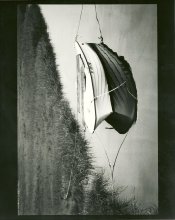Well, I did an extensive series of tests today using the Efke direct positive, matte finish paper.
I had done some tests last year, enough to know that this paper requires a significantly greater amount of preflash than what I normally give to conventional paper negatives to control contrast. As a comparison, my normal paper negative preflash time is around 8 seconds of light using my specially-built lighting source in my darkroom; the Efke paper requires 28 seconds.
Today's tests were done also to confirm a good working exposure index, which for my process and equipment ended up being at 1.6. I discovered that this paper exhibits some very frustrating tendencies of reciprocity failure, even within exposure times that film (and certainly conventional printing paper) would have no issues with. For instance, I did two exposures, one at f/22 and 2 seconds, the other at f/5.6 and 1/10 second, both should have given the same density since they're equivalent exposures on my meter; the results varied widely. In comparison, I've used normal printing paper in both pinhole and glass lensed cameras and have not seen significant reciprocity failure from exposure times as little as hundredths of a second to upwards of 5 minutes or longer. This Efke paper is a different breed entirely.
This led me to the principle of keeping the preflash and in-camera exposure times constant, and varying the subject's lighting and the f-stop in order to arrive at the correct metered exposure. I bottomed out on a 1-second exposure in the camera, accompanied by the 28 second preflash in the darkroom, and varied the Speed Graphic's Ektar lens aperture to adjust exposure according to the handheld meter's recommendation at EI=1.6.
Even so, minute variations in exposure time result in visible differences in print density. But my results point to being able to use this paper and achieve almost normal contrast images. I say "almost" because the d-max of the paper appears to be not nearly as dense as what I'm used to with fine printing papers.
I'm hoping to eventually try out the Harman paper and see if it performs significantly better. At least we would have the option of a fiber based paper.
I'll get some sample images from my series of tests posted soon.
~Joe














